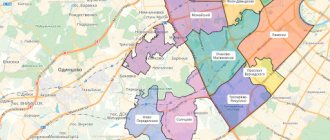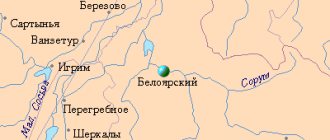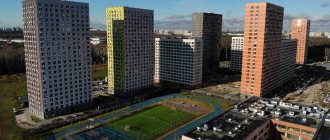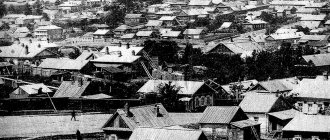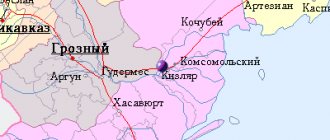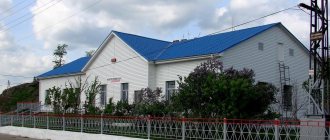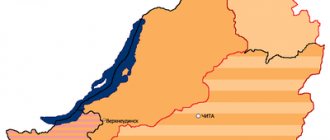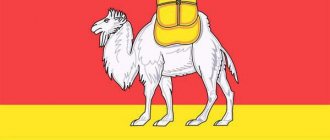New culture and recreation parks
Khasavyurt occupies one of the first places in the republic in terms of the number of green spaces. (300 hectares). In 2001, in the Vostochny microdistrict, along Groznenskaya Street, a new cultural and recreation park was founded, which quickly became a favorite vacation spot for citizens and guests of the city.
In the 2010s, serious work was also carried out in Khasavyurt to improve the urban area. In November 2022, a solemn opening ceremony of another new cultural and recreation park took place, as part of the implementation of the federal priority project “Formation of a comfortable urban environment.”
In the Family Park in Khasavyurt
But in general, there is such a funny moment - on the streets of Khasavyurt you can easily meet a flock of sheep or a herd of cows. For example, in mid-spring, shepherds drive cattle from distant villages to mountain pastures in the Kizilyurt area, and their path runs right along the roads that go through Khasavyurt. This fact gives the city of Khasavyurt additional provincial comfort and oriental flavor.
Climate and ecology of Khasavyurt
The climate in the Khasavyurt region is typical for this area. In summer the air temperature reaches +40°C, and in winter it drops to -15°C. Winds throughout the region are cold and piercing. The whole year can be divided into several weather stages:
- Winter – snow, frosty wind, dim sun.
- Spring – favorable sunny weather, warm wind.
- Summer is hot sun.
- Autumn – heavy rains, dry wind.
Winter in Khasavyurt
Despite the fact that, according to analysts, Khasavyurt is one of the ten most favorable cities for life from an environmental point of view, it is still difficult to call it such. The city is quite polluted. Due to the fact that Khasavyurt is the center of trade in Central Dagestan, the entire area is literally cut up by roads and highways. People come from all over Dagestan, both from nearby cities and from distant villages, to the markets and bazaars of Khasavyurt. A huge amount of transport and no less number of various small industries cannot have a beneficial effect on the ecology of the city.
In addition, within the city there are several factories and combines: canning, meat, dairy, wine, and brick. There is also a reinforced concrete products plant and several furniture factories. The entire line of highways is dotted with all kinds of car washes and tire shops.
Another rather negative factor in the ecology of the area is that the terrain is flat. Strong winds prevailing in the republic carry dust, gas and garbage from the city center to the very outskirts. Despite the efforts of housing and communal services, waste disposal is carried out more slowly than necessary. Not far from the Andean village, not far from the city, there is a huge landfill, where garbage is regularly burned. Despite many years of complaints from city and village residents, the city administration will not completely eliminate the landfill.
Cleanup day on the streets of the city
Thus, Khasavyurt is more of a city for work and business than a place for a calm and carefree life.
About the history of the city
In June 1826, General Ermolov ordered Musa Khasav to build a permanent settlement with a military garrison on the Yaryksu River to protect the villages of the Kumyk Plain from Chechen predatory raids. Khasav immediately carried out this order: he placed one hundred families from the villages of Endirei and Kostek in the newly formed village.
In 1831, the village of Khasavyurt was destroyed by a Chechen raid, but was quickly restored. In the 1840s, it was decided to build a fortress in the village of Khasavyurt, designed to finally block the path to robbery by the Chechens on the Kumyk Plain.
In 1846 and 1848, the construction of two fortifications of the fortress was completed, and the 80th Kabardian Jaeger Regiment was stationed there on a permanent basis. The fortifications consisted of an adobe wall one and a half meters thick and 2.5 m high, with three brick towers and loopholes in the corners. The western side did not need a wall: there was a cliff on the bank of the Yaryksu River.
Between the two fortifications there was a outstadt - the houses of officers and family soldiers. A deep ditch was dug along the fortification and outpost. In 1867, after the establishment of peace in the North Caucasus, Khasavyurt became a settlement with civilian administration.
Coat of arms of Khasavyurt.
The construction of the railway in Dagestan (1893) brought significant changes to the economic life of Khasavyurt. The population began to sell walnut trees and nuts, dried fruits, wines, canned goods, leather, wool, and carpets to the Russian domestic market in large quantities. This contributed to the rapid development of crafts and trade. The education system also began to take shape. Both men's and women's schools operated in Khasavyurt (however, before the revolution, Muslim women did not study there).
In 1917, 14 thousand people lived in Khasavyurt, half of them were Cossacks and Russians. During the civil war, the settlement of Khasavyurt was burned by one of the bandit detachments that were then operating in abundance throughout the region. After the civil war, residents restored the settlement. And in 1931, Khasavyurt was given the status of a city. In the same year, the first hospital opened here. And it was opened by the former famous doctor and scientist Pirogov.
During the difficult years of chaos and war in Chechnya in the 1990s, Khasavyurt received more than 80 thousand refugees from this republic. Its residents were the first in Dagestan to lend a helping hand to the civilian population of Chechnya. Many Chechens remained to live in Khasavyurt after the war.
Khasavyurt
Video: Khasavyurt
Basic moments
Khasavyurt was located on the Kumyk Plain, which at the beginning of the Caucasian War turned into an arena of fighting between the highlanders who did not want to submit to the Russian Empire and the tsarist troops. In those turbulent years, the Decembrist Alexander Bestuzhev, Alexander Dumas the father, and Alexander Griboedov visited here. Leo Tolstoy also visited here more than once. His communication with the Kumyks, soldiers and officers of the Kabardian regiment stationed in Khasavyurt was reflected in such wonderful works as “Hadji Murat”, “Adolescence”, and several short stories.
After the end of the Caucasian War, Khasavyurt expanded, grew richer, and by the beginning of the 20th century earned the reputation of one of the most beautiful cities in Dagestan. There is little left here from pre-revolutionary times, when a significant part of the local population were Russian settlers. But, fortunately, the city has preserved the wonderful Znamensky Cathedral, which is called the Orthodox pearl of the Caucasus.
Today, Russians make up just over 2% of the total population of Khasavyurt. The vast majority of local residents are Avars, Chechens, and Kumyks. In addition, here you can meet representatives of all ethnic groups inhabiting the republic. Thanks to this, the city is often called little Dagestan. Almost all Khasavyurt residents are engaged in commerce. It seems that everyone is trading here, and city life is centered around large markets. Prices at local bazaars serve as a real benchmark in the region. Dagestan merchants, wanting to emphasize the cheapness of their goods, proclaim: “The cost is lower than in Khasavyurt.”
On city streets, women in closed, wide clothes, stern, bearded men are increasingly seen, and local youth are actively showing interest in religion. Studying at the Islamic University of Khasavyurt, in a madrasah, is considered prestigious. About fifty mosques have been built in the city, many shops sell Islamic religious paraphernalia and literature.
Khasavyurt is not a tourist city. There is no appropriate infrastructure here, the hotels leave much to be desired. Compensation is provided by local cafes and restaurants, which offer very tasty, satisfying and inexpensive food. The chefs prepare their dishes from regional products, which is important, because Khasavyurt is one of the most environmentally friendly cities in Russia. There is not too much entertainment here. Local residents, as a rule, spend their time well in city parks and family cafes. At the same time, many townspeople who profess Islam are extremely dissatisfied with the fact that there are establishments that sell alcohol in Khasavyurt. But, basically, representatives of all nationalities have good neighborly relations with each other and are distinguished by cohesion.
History of Khasavyurt
The fortification called “Khasavyurt” was first mentioned in military reports of the Russian Empire for 1847. But on the map of the North-Eastern Caucasus, compiled back in the 30s of the 19th century, the village of the same name was already indicated. The area in which it was located occupied part of the Kumyk Plain, which historically belonged to the Kumyk princes - one of the few Dagestani rulers who supported Russia in its ambitions in the Caucasus.
The settlement on the banks of the Yaryksu (Yaryksu) river was founded by the chief Kumyk bailiff Musa-Khasav (Utsmiev), a prince and major of the Russian army, following the order of General Alexei Ermolov. He placed a military garrison in the village, and then resettled there 100 families from the large neighboring villages of Endirei and Kostek. Basically, these were Kumyks, as well as Persians and Armenians. At Ermolov’s suggestion, the new village was named after his longtime comrade Musa-Khasav. In 1831, Imam Gazi Magomed, during one of the raids, destroyed the village of Khasavyurt. The settlement was restored, but it turned into a real fortification later.
At the turn of the 30s and 40s, the highlanders, led by Shamil, carried out successful operations against the tsarist troops and ravaged the Kumyk villages in retaliation for the fact that the local princes “sold themselves to Russia.” And although there were effective fortifications on the approaches to Khasavyurt, the Yaryksu River valley itself remained unprotected. Taking into account the strategic importance of the area where the village was located, the commander-in-chief of the troops in the Caucasus, Lieutenant General Joseph Gurko, decided to build a reliable fortification on the high steep bank of the Yaryksu.
The construction of the fortification, which was supposed to block the mountaineers’ access to the Kumyk plane, began in 1846. It was built one and a half kilometers from the village (now in the area of the bus station) and named after the river. Soldiers of the Kabardian regiment were involved in the work, from which a garrison was formed. In 1847, the Yaryksuv fortification was renamed Khasavyurt. Subsequent attacks by the highlanders revealed the shortcomings of the fortification, and in 1848, in the area of the modern Central Market, they began to build a more powerful fortification with three brick towers and corner loopholes. It was surrounded on three sides by an adobe wall one and a half meters thick and 2.5 meters high. On the western side, the fortification was protected by a high bank that dropped to the river.
Between the first and second fortifications, a suburb arose, where families of Russian officers and soldiers settled. They flocked to Khasavyurt after 1856, when lower military ranks were allowed to send their closest relatives there for permanent residence. After the end of the Caucasian War, military control in this region was abolished. In 1867, Khasavyurt received civil status, becoming a settlement, and then the center of the Khasavyurt district of the Terek region, remaining so until 1920.
In the small settlement there were 7 main streets crossed by eleven minor ones, 3 squares with fountains. About three hundred public and private buildings, churches, and mosques were erected here, where children from Islamic families studied Islamic law and Arabic. In 1860, a men's school was opened in Khasavyurt, and in 1875, a women's school, which, however, was not available for the education of Muslim women. In the 80s, leather factories, soap factories, mead factories, flour mills, distilleries, and agricultural products processing enterprises already operated here. Sloboda was an important link in the postal system of the Caucasus.
Gradually, Khasavyurt turned into the main regional trade center. Merchants from all over Dagestan came to its famous autumn fairs. An additional impetus for commerce was given by the opening in 1894 of the Vladikavkaz railway line Beslan - Petrovsk (Makhachkala), laid through Khasavyurt.
At the end of the 90s, cholera broke out in the settlement, claiming many lives. The population here has decreased significantly, but shortly before the First World War, a stream of immigrants from the central regions of Russia poured into these regions. By 1914, Russians made up a quarter of the settlement's population. The settlers were attracted by the fertile lands in the vicinity of Khasavyurt, and they quickly turned them into profitable plots.
The war disrupted the economic well-being of Dagestan, and the events of 1918 plunged it into complete ruin. In the spring of that year, the settlement was plundered and burned by the murids of Uzun-Khadzhi, a Dagestan political and religious leader who advocated the establishment of Sharia law in the region. It is believed that the pogrom of the last Russian settlement in the Kumyk Valley, not yet destroyed by the highlanders, was revenge for the capture of Petrovsk by the Bolsheviks.
Turned into ruins, Khasavyurt began to be revived in the 20s, but most of the historical buildings were never rebuilt. In 1931, the settlement, which returned to life, received the status of a city of regional subordination.
During the Great Patriotic War, evacuation hospitals were organized in Khasavyurt, which was located near the combat zone. Front-line soldiers who died from their wounds were buried in a common cemetery. Today there is a memorial here. Khasavyurt entered the modern history of Russia as the city where agreements were signed that put an end to the First Chechen War.
Geography and climate
Khasavyurt is located in the north-west of Dagestan, 90 km from the capital of the Republic of Makhachkala, located on the shores of the Caspian Sea. About 10 km from Khasavyurt lies the border of Chechnya. The city lies on the Kumyk Plain, in the interfluve of the Aktash and its tributaries – the Aksai and the Yaryksu. To the south of this area lies the high-mountainous Salatau ridge, but closer to the local latitudes its spurs completely disappear, turning into a steppe lowland. Fertile lands in the vicinity of Khasavyurt are plowed. Grains, melons and vegetables are grown here. Cherries, apricots, peaches, cherries, apples and pears of various varieties grow in the gardens. To the north of the city there is a forest area.
Khasavyurt is located on an area open to all winds. According to local legends, even before the appearance of the village of Khasavyurt, the Kumyks repeatedly tried to found a village on this piece of land, but constantly abandoned their plans due to the climate. According to some reports, before the Caucasian War there was a guard post here, which was called “Suvuk Purshumuk” (“Cold Stop”). They also say that shepherds stopped for several days in this windy place, driving cattle to summer pastures. It attracted them due to the complete absence of mosquitoes and flies.
Wind in Khasavyurt is a common occurrence. In winter it is cold and piercing, in spring and autumn it is mostly warm, and in summer it is dry but refreshing. Winters here are mild and short, the sky at this time is often cloudless, but the sun shines dimly. The air temperature usually fluctuates between –3…+5 °C, snow falls only occasionally. Spring comes to the city already at the beginning of March, and at the end of this month it is already about +15 °C during the day. Thermometers approach the 20-degree mark in the third ten days of April, and in May they steadily exceed it.
Summer in Khasavyurt is sultry: during the day, on average, +28...+32 °C, and at night – about +25 °C. In early autumn it is still hot and sunny. In October it starts to get colder, the temperature drops below +20 °C. In late autumn there are heavy showers; in November it is usually +7...+11 °C.
Sights of Khasavyurt
Khasavyurt is a very unique city. It will not leave travelers indifferent, despite the fact that the historical sights here can be counted on one hand, and modern architecture is not distinguished by outstanding achievements. The heart of Khasavyurt beats in the Central Market area, surrounded by buildings with advertising signs. Their ground floors are occupied by pizzerias, shops, dental clinics, grocery stores and bookmakers. Beauty salons are attracted to posters showing celebrities with fashionable hairstyles. From the densely built main streets there are narrow, tunnel-like streets without names, along which merchants and other people busily scurry about.
The further you are from the noisy and bustling center of Khasavyurt, the cleaner the streets and the calmer the atmosphere. Outlying villages are included within the city limits, and each of them is quite distinctive. Village named after Michurin is inhabited mainly by Chechens who fled their homeland during military conflicts. In the villages of Vostochny, Balyurt and Aerodrom, in addition to Chechens, Avars and Kumyks live. The most prestigious areas are the villages of Neftekachka and Andiysky, where the majority of the population is Andian. City officials and their numerous relatives and successful businessmen settled in Andiyskoye. Here the mansions look like palaces, and the mosque can rival the richest Muslim temples in the Arab world in the splendor of its decoration.
The Juma Mosque, the main cathedral mosque of Khasavyurt, where collective Friday prayers are held, is located on Buynaksky Street. Almost opposite it stands the impressive building of the Islamic University named after Saidbeg Daitov, which opened in the 2000s. Here students study Muslim sciences and Arabic. From time to time, the educational institution organizes competitions for religious knowledge. The program includes reading the Koran and reciting its sections by heart. The winners are awarded quite valuable prizes, for example, a new car, a large sum of money or a trip to Hajj at the expense of the competition organizers.
Among the university students there are mainly young people, but there are also adults. There are a lot of people who want to come here, but only about 100 people are accepted per year. The prestigious educational institution is of interest not only to applicants, but also to law enforcement agencies, who annually scrutinize the lists of all applicants.
Traces of the Russian past in Khasavyurt have been practically erased, but its main symbol has been preserved - the majestic 49-meter cathedral in the name of the Icon of the Sign of the Blessed Virgin Mary, the largest Orthodox church in the North Caucasus. The cathedral was built in 1903-1904, and its construction was timed to coincide with the 300th anniversary of the Romanov dynasty. Crowned with nine domes, it is a striking example of neo-Byzantine architecture. Before the revolution, the interiors of the temple were skillfully decorated with stucco and painting, but nothing remained of the former luxury. The main damage to the building was caused by a fire that occurred in 1943.
Once upon a time, the cathedral ensemble occupied a vast territory, but today the lands belonging to the temple are built up with modern buildings. The cathedral is surrounded by a fence, behind which a shady park is planted. The spacious interior space, capable of accommodating up to 1000 people, is extremely rarely crowded, and the abbot is sincerely happy to see every parishioner and rare tourists. It is curious that Muslims most often donate to church needs. There is a small shop near the cathedral that sells icons, candles, and books.
You can get acquainted with the history and culture of Dagestan at the Khasavyurt Museum of Local Lore. It is located on Toturbieva Street, 26, in a merchant's house built in 1902. The museum exhibition is housed in three halls. The historical and archaeological location displays artifacts found on the territory of the republic dating back to the Bronze Age period, military ammunition of medieval warriors, and genealogies of Kumyk princes. In the hall dedicated to ethnography, you can see household items of representatives of numerous nationalities that have inhabited Dagestan since ancient times, as well as their national outfits, accessories, and jewelry made of silver.
The third, largest hall, includes an exhibition dedicated to the Great Patriotic War and the townspeople who took part in the battles. The memory of those times is also captured in numerous sculptures installed on the streets and squares of Khasavyurt. One of the monuments, located in the very center of the city, on the Dylymsky ring, is dedicated to the Hero of the Soviet Union Elmurza Dzhumagulov. In honor of his feat, during one of the tank battles in Belarus, a pedestal was erected on which a formidable combat vehicle was hoisted. The city also preserves monuments dedicated to the Dagestanis who died during the civil war. The parks of Khasavyurt are decorated with curious modern sculptures and fountains, of which there are more and more of them lately.
4 km from the city center there is an important archaeological site - the Andreyaul settlement, dating back to the 2nd-9th centuries. So far, this is the only real trace of the era of the Khazar Empire found. The remains of the ancient settlement stretch for 1.5 km along the Aktash River, near the village of Andreevskaya (the village of Endirei or Enderi). A number of researchers believe that in the immediate vicinity of this place there was the early capital of the Khazar Khaganate - the city of Selender. The Andreyaul settlement may have served as a stronghold during the Arab-Khazar wars.
Archaeologists discovered the relief outlines of the settlement of the ancient settlement, its citadel, surrounded by a moat and massive ramparts reaching 10 meters in height. In the southern part of this archaeological location, a whole production complex of pottery kilns was discovered, which testified that their own ceramics were made here.
Entertainment
You can get acquainted with the traditions of the peoples of Dagestan at the Central House of Culture (Kazbekova St., 3), where concerts, festivals of mountain and Cossack songs and dances are regularly organized. The Spartak House of Culture, located in a beautiful pre-revolutionary building on Toturbieva Street, 79, houses creative studios. Performances by local and visiting musicians, theater artists, as well as folklore festivals and pop competitions are held at the Center for Traditional Culture of the Peoples of Russia (75 Nekrasova St.).
At Makhachkala Ring, 206, there is a children's playground called Bubble Park. There is an entertainment area for kids here, there are several slot machines, and exciting quests are offered. There is a cafe in the complex.
Another popular vacation spot among residents of Khasavyurt is the Family Territory (Pobedy St., 109A). Fun events and theatrical performances are regularly held here. Family is especially crowded on New Year's holidays and on Family Day.
With the growth of the Muslim population in Khasavyurt, the number of entertainment establishments, as well as shops selling alcohol and tobacco, is gradually decreasing. Moreover, local residents are often extremely disrespectful towards sellers of alcohol and cigarettes. However, about two dozen pubs and bars still welcome guests. Establishments usually close at 22:00-23:00. Hookah bars are open longer – usually until one in the morning. Those who can’t sleep can head, for example, to the gaming club “Hyper” (Makhachkala highway, 25G), it is open around the clock.
Purchases
The core of Khasavyurt is the Central Market. And if chaos reigns around this huge bazaar, its internal space is perfectly organized. It’s clean and beautiful, the goods on the shelves are neatly displayed, as if for a photo shoot. There are about a thousand retail outlets in the market. Selected fruits and vegetables, berries, honey, canned food, cheeses, meat and fish of all varieties and in different forms, melons, and aromatic pastries are sold here. At the same time, there is trade in clothing, linen, dishes, equipment, and auto parts. Near the main rows there are sellers offering all sorts of things: toys for children, inflatable balls, hairpins, key rings, various accessories.
In addition to the Central Market, in Khasavyurt there are Green, Eastern, Carpet markets, as well as a wholesale clothing bazaar called “Kupa”. Like most cities in Dagestan, there is a Gold Market. This is the name given to bazaars where jewelry is sold directly in shopping arcades, and not in showrooms. Traders tempt you with products created in local workshops, as well as counterfeit products mainly from Turkey, the UAE, and Azerbaijan. There are other retail outlets in the city, not so large.
As delicious souvenirs from Khasavyurt you can bring urbech - a sweet paste made from nuts or seeds, sugar, honey, butter (from 150 to 1000 rubles depending on the packaging capacity), bekmes - a very thick berry or fruit syrup (from 1000 rubles). Tourists willingly buy nut grass (from 50 rubles/glass) - a spice that gives dishes an unusual taste. A popular product among visitors is dried meat (from 600 rubles/kg), a delicious treat made from lamb or beef, reminiscent of basturma, but prepared differently. The fish stalls sell a local delicacy - zalom (Kessler's herring or king herring). The hefty fish, costing from 160 rubles per kg, are incredibly tasty, but are considered perishable products.
The largest shopping mall (70 Gamidov St.). Here you can buy high-quality and inexpensive clothing, including Islamic clothing, household goods, perfumes, cosmetics, and certified gold jewelry. The shopping center has a food court, a fitness salon for girls, and a tailoring studio.
Cafes and restaurants
Travelers who have visited Khasavyurt speak highly of the local cafes and restaurants. The city's culinary establishments serve dishes made from local, organic ingredients. The meal is inexpensive, and the portions are usually quite impressive.
One of the best restaurants in the city is “Oasis” (Daibova St., 22). There are banquet halls and cozy booths in oriental style on two floors. Visitors are especially impressed by the variety of kebabs, salmon steaks, veal, and lamb. Clients note a high level of service. Lunch will cost 740-1900 rubles per person. Alcoholic drinks are not served here. Dinner at the Dvorik restaurant (Imam Shamil St., 146) will cost a little more. The menu includes dishes of Caucasian cuisine. And you can taste the best pizza and pasta in the city at the Sicily restaurant (Buinaksky St., 118).
There are many culinary establishments in Khasavyurt, where you can have an inexpensive meal - from 270 rubles per person. The family cafe “Naples” (41 Aliyeva St.) serves pizza, shawarma, shish kebab, and sushi. There is a 24-hour food delivery service here. Lovers of Middle Eastern cuisine and strong coffee should check out the Damascus and Aleppo cafes, and fans of Turkish cuisine should check out Istanbul.
A variety of snacks, a wide selection of beer and unobtrusive music await guests of the hookah bars “Dubai” (Groznenskaya St., 86-A), “Abu Dhabi” (Vorobyova St., 48). Popular pubs include Olympus and Orel. Most of these establishments open at 13:00, but some receive visitors as early as 10:00.
Where to stay
The choice of hotels in Khasavyurt is small. Perhaps the most famous of them is “Flamingo” (Magidova St., 149). The rooms in this three-star hotel are equipped with TVs, refrigerators, and kitchenettes. There is a bar. However, many guests note that it is not very comfortable and clean here, although the staff is friendly. The price range for accommodation is 1731-2485 rubles per day.
The Kiev Hotel (10 Makhachkala Highway) has better reviews. There are rooms of different categories available here - from standard to VIP class. The hotel has a cafe with home-cooked food, parking, a market and a public transport stop nearby. You can rent a room here for 1,875 rubles or more. On Makhachkala Highway there is also a budget hotel “Dynamo”, where prices start from 690 rubles.
Daily accommodation in the Sulak guest house (Suleiman Stalsky St., 13), surrounded by its own garden, will cost from 1,070 rubles. It offers comfortable rooms, each of which has a small kitchen and bathroom. Guests have access to free Wi-Fi and private parking.
Hotel deals
Booking.com
Transport
Urban transport in Khasavyurt is not well developed. Passengers are transported only by minibuses. There are also several companies providing taxi services. The cost of boarding is 50-100 rubles, the price of a trip within the city is from 15 rubles/km, outside the city – from 25 rubles/km.
There is a bus station on Buinaksky Street, 163. From here buses regularly depart to Makhachkala, Derbent, Volgograd, and to the cities of the Krasnodar Territory, including the resorts of Sochi and Anapa.
How to get there
You can quickly get from Moscow to Khasavyurt through the capital of the republic, Makhachkala, which is connected by daily direct flights to Moscow airports Vnukovo, Sheremetyevo and Domodedovo.
Buses No. 102 heading to the center of Makhachkala stop at the arrival terminal of Whiteash Airport. In the schedule of the city bus station "Severny" (Ali-Gadzhi Akushinsky Ave., 100) you will find several daily flights to Khasavyurt. Travel time – 1 hour 20 minutes. A taxi ride from Whiteash airport to Khasavyurt will cost from 2250 to 3200 rubles, depending on the class of the car. The distance from Makhachkala to Khasavyurt is 90 km, you need to move northwest along the E50 highway.
By rail you can get to Khasavyurt by train No. 135A “St. Petersburg - Makhachkala”. The train travels through Tver, Moscow (Kursky Station), Rostov-on-Don, Minvody, Gudermes. From the Northern capital to the Khasav-Yurt railway station, the train takes 51 hours 32 minutes.
Holy Sign Cathedral
The largest Orthodox church in the entire North Caucasus, the Holy Sign Cathedral of Khasavyurt is the main historical and architectural monument in the city. Built at the beginning of the twentieth century (1903), by the Cossacks of the Terek Cossack Army and the Russian residents of Khasavyurt, it is a prominent representative of the neo-Byzantine architectural style.
The temple is forty-five meters high and has a harmonious and symmetrical artistic architecture. This is a cross-domed structure, which is crowned with 9 domes, in honor of the nine angelic ranks.
Stone, brick and ceramics - everything necessary for the construction of the temple was taken directly on site. It is known that chicken eggs were collected for the bonding solution. The temple had rich interior decoration, paintings, and stucco moldings. But during the civil war, the entire interior and paintings of the temple were destroyed by banditry mountaineers. Despite the fact that there is now very little Christian population left in Khasavyurt, the temple is still operational.
Address: st. Toturbieva, 121 (formerly Sergo Ordzhonikidze Street).
Population of Khasavyurt
As mentioned earlier, today (beginning of 2014) the population is 135 thousand people.
The national composition is quite diverse: Avars, Chechens, Russians, Kumyks, Dargins, Laks - this is only a small part of the city's population. Dagestan has 36 nationalities. We can say with confidence that representatives of absolutely all nationalities are present in the city of Khasavyurt. Thus, the religious composition of the region is also not homogeneous: Orthodox Christians, Catholics, Jews, Islamic Sunnis and Shiites. But, despite such a wide variety of nationalities and religions, residents of the city and region are in good neighborly relations with each other. Perhaps thanks to common schools and institutes, whose teachers do not discriminate between students. Perhaps thanks to the old people who instill in the youth the norms of morality and friendship. It is possible that there are other reasons for this, but the population is united.
9th May
On the streets you can increasingly see women in closed, loose clothing, hijabs, and men with beards. Not only young people, but also adults and accomplished people are interested in religion. This situation cannot but rejoice.
In addition, the city’s youth strive to obtain education and professions. Moreover, everyone chooses education at their own discretion: professional or religious. A large number of institutes and madrassas contribute to this. This has a positive effect on the general moral character of young people in the city.
While young people are gnawing on the granite of science, the older generation for the most part is engaged in large or small businesses. The population of the city is mainly engaged in trade, business, trade and car repair. Cattle breeding and farming have faded into the background over the years.
Islamic University named after Saidbeg Daitov
The pride of Khasavyurt is the Saidbeg Daitov Islamic University. It bears the name of a wealthy merchant who acted as a patron of the arts during the construction of this educational institution and in every possible way supported the education and creative development of the city's youth. University students study various Islamic sciences, as well as Arabic. Various competitions are held here among reciters of the Koran, hafiz (those who know the Koran by heart), and competitions for religious knowledge.
Islamic University named after Saidbeg Daitov
Address: st. Buynaksky, 115b.
Synagogue in Khasavyurt
Since ancient times, mountain Jews have lived in the Khasavyurt region - since the era of ancient Khazaria, the Jewish state that existed from 650 to 969 and was crushed by Prince Svyatoslav. According to the 1897 census, in Khasavyurt there were 762 Jews out of 5,312 residents. But subsequently their community gradually declined. Many left for Israel during the years of perestroika and chaos in the 90s. In the early 2000s, no more than 20 Jewish families remained in Khasavyurt. The ancient synagogue, the interior of which was destroyed during the civil war, has been converted into a sports hall.
Synagogue in Khasavyurt
Criminal situation
Since the 90s, when the first explosions took place in the city, the criminal situation has not changed much. In the media: on television and in newspapers, information is disseminated about the difficult criminal situation in the republic, in particular in large cities such as Khasavyurt. But in reality the situation is a little different. Islamic guerrilla groups do not fight civilians. All their conflicts with law enforcement agencies almost never threaten people’s lives, however, they still disturb the peace. It is not always possible to remain calm when there is a shootout in the house next door. Fortunately, the number of such situations is not large. However, a certain stability can be observed. Not a month goes by without the secret services discovering buried weapons, or without neutralizing a member of a partisan detachment.
In addition to religious groups, there are a number of simple bandits who are trying to get rich without making much effort. Since Khasavyurt is a trading city, the main criminal activity is theft.
In addition, blood feud has not been eradicated. For the murder of an innocent person, an entire village can rise up against the criminal. More recently, at the beginning of 2013, law enforcement agencies registered a similar case. Residents of the Kumyk village of Khasavyurt district came out with a mass demonstration to the city administration. Some of them separated and moved towards the Caucasus highway. Near the village of Mutsal - Aul, the highway was blocked and traffic was stopped. People demanded the immediate intervention of the city authorities in the case of the murder of their fellow villager. Everyone knew the name of the criminal, who, taking advantage of his high status in society, was confident of his impunity. Fortunately, the case never gained momentum, and the city authorities took all measures to ensure that the criminal was punished.
Also, one cannot fail to note the high level of bribery in the city.
Even despite the large number of study places, you can enter a university or get a good position either through family ties or through a bribe. Most often, there is no punishment for this type of crime. And the city residents are not too eager to change the situation.
Thus, the overall criminal situation in the city is quite tense. On the one hand, there are “forest brothers” who strive to eradicate debauchery and establish the laws of the Almighty through military means. On the other hand, there are townspeople who do not want to comply with the laws of the Russian Federation. However, despite the negativity, city residents know how to find positive moments and enjoy life.
Dylym ring
In the very center of the city of Khasavyurt there is the Dylym ring, on which there is a pedestal with a Soviet T-72 tank. This monument is dedicated to the Hero of the Soviet Union, senior lieutenant Elmurza Dzhumagulov (1921-2013). In June 1944, 2 tanks from his platoon were the first to cross the Drut River near the city of Rogachev (Belarus) and burst into the depths of the Nazi defensive line.
Dylym ring
During the battle, Dzhumagulov's tank was hit. He was wounded and burned, but together with his crew he rushed into the German trenches and engaged in hand-to-hand combat with the enemies. For outstanding courage and heroism, Senior Lieutenant Dzhumagulov was nominated for the title of Hero of the Soviet Union. In total, during the Great Patriotic War, he participated in approximately 50 tank attacks and was wounded four times. Elmurza Biymurzaevich is a native of the village of Karlanyurt, Khasavyurt district.
Address: st. Dylym ring.
Notable natives
Politicians
- Leonid Grigoryevich Bugaenko (1911-?) - Soviet party leader, chairman of the Vinnitsa regional executive committee, deputy of the Supreme Soviet of the Ukrainian SSR of the 6th-7th convocations
- Zainalov Shamil Magomedovich (born 1946) is a Russian statesman and political figure.
- Gadzhi Nukhievich Makhachev (1951-2013) - Russian public and statesman, Doctor of Law, professor, deputy of the State Duma of the Russian Federation of two convocations
- Sergei Nikolaevich Reshulsky (born 1951) is a Russian political figure. Deputy of the State Duma of the 1st-7th convocations
Warlords
- Mikhail Petrovich Vorobyov (1896-1957) - Soviet military leader, Marshal of the Engineering Troops (1944)
- Vladimir Valentinovich Chirkin (born 1955) - Russian military leader, Colonel General (2011), Commander-in-Chief of the Ground Forces (2012 - 2013)
- Sultan Shavkhalovich Jamaldinov (born 1935) - Russian military leader, major general
Cultural figures
- Victoria Evgenievna Isakova (born 1976) - Russian theater and film actress, laureate of the Government of the Russian Federation (2015)
- Umukursyun Arzulumovna Mantaeva (1924-2011) - people's writer of Dagestan
- Abdulzagir Bozgitovich Musaev (born in 1951) - Russian artist, corresponding member of the Russian Academy of Arts, Honored Artist of the Russian Federation
Scientists
- Vsevolod Aleksandrovich Egorov (1930-2001) - Soviet and Russian mathematician and mechanician, Lenin Prize laureate
- Akhmed Ibragimovich Osmanov (born 1935) - Soviet and Russian historian, corresponding member of the Russian Academy of Sciences
Entrepreneurs
- Lazar Shaulov (born in 1969) – founder of the Unitile holding
Athletes
Freestyle wrestling and boxing
- Buvaysar Saitiev (born 1975) - freestyle wrestler, three-time Olympic champion (1996, 2004, 2008)
- Mavlet Batirov (born 1983) - freestyle wrestler, two-time Olympic champion (2004 and 2008)
- Adam Saitiev (born 1977) - freestyle wrestler, Olympic champion
- Murad Umakhanov (born 1977 - freestyle wrestler, Olympic champion
- Ramazan Shahin (born 1983) - freestyle wrestler, Olympic champion
- Elmadi Zhabrailov (born 1965) - freestyle wrestler, Olympic silver medalist, world, European and Asian champion
- Murad Gaidarov (born 1980) - freestyle wrestler, Olympic silver medalist
- Albert Saritov (born 1985) - freestyle wrestler, Olympic medalist
- Artur Beterbiev (born 1985) - boxer, world champion and two-time European champion among amateurs, world champion in the light heavyweight category according to IBF (2017–present)
- Lukman Zhabrailov (born 1962) - freestyle wrestler, world and European champion
- Akhmed Atavov (born 1961) - freestyle wrestler, world champion
- Zaur Uguev (born 1995) - freestyle wrestler, world champion
- Bagautdin Umakhanov (born 1971) - freestyle wrestler, two-time European champion
- Zaur Botaev (born 1979) - freestyle wrestler, European champion
- Akhmed Gadzhimagomedov (born 1990) - freestyle wrestler, European champion
- Abdulla Magomedov (born 1962) - freestyle wrestler, European champion
- Makhmud Magomedov (born 1986) - freestyle wrestler, European champion
- Murad Ramazanov (born 1977) - freestyle wrestler, European champion
- Zelimkhan Khuseynov (born 1981) - freestyle wrestler, European champion
- Adam Batirov (born 1985) - freestyle wrestler, Asian champion
Mixed martial arts
- Zabit Magomedsharipov
- Musa Khamanaev (born in 1987) - World Champion according to M-1 Global, fighter of the ACA league.
Football
- Arsen Akayev
- Ibrahim Hasanbekov
- Kafar Kafarov
Monument to Soltan-Said Kazbekov
In the center of the city of Khasavyurt, near the building of the Khasavyurt Agricultural College (today - the Agrarian Economic College) there is a monument to the Dagestan communist Soltan-Said Kazbekov, who died at the hands of enemies of Soviet power in March 1920; This educational institution itself is named after him.
Monument to Soltan-Said Kazbekov
Address: st. Toturbieva, 61.
Monument to Zainalabid Batyrmurzaev
The monument to the poet and communist, who, like Kazbekov, died during the civil war at the hands of Denikin’s followers, at only 22 years of age, was erected on the central square of the city of Khasavyurt, which bears the name of this man.
Monument to Zainalabid Batyrmurzaev
Location: Batyrmurzaev Square.
Climate
The city is located in a temperate climate zone, an area of moderate continental climate.
| Climate of Khasavyurt | |||||||||||||
| Index | Jan. | Feb. | March | Apr. | May | June | July | Aug. | Sep. | Oct. | Nov. | Dec. | Year |
| Average maximum, °C | 1,4 | 2,7 | 7,7 | 16 | 22,5 | 27 | 29,7 | 28,9 | 23,6 | 16,5 | 9,3 | 4 | 15,8 |
| Average temperature, °C | −1,8 | −0,7 | 3,8 | 10,9 | 17,3 | 21,8 | 24,6 | 23,8 | 18,6 | 12,1 | 5,9 | 1,1 | 11,5 |
| Average minimum, °C | −5 | −4,1 | 0 | 5,9 | 12,2 | 16,6 | 19,5 | 18,8 | 13,7 | 7,8 | 2,6 | 1,8 | 7,5 |
| Precipitation rate, mm | 20 | 23 | 22 | 32 | 51 | 60 | 43 | 35 | 40 | 36 | 30 | 22 | 414 |
| Source: Climate-Data.org | |||||||||||||
Monument to Rashid Askerkhanov
The monument to the outstanding Soviet cardiologist, participant in the Great Patriotic War, author of hundreds of scientific works - Rashid Pashaevich Askerkhanov - was erected on the territory of the Khasavyurt Central City Hospital. It bears the name of this great doctor.
Monument to Rashid Askerkhanov
Address: st. Alieva, 21.
Monument to Tulpar Musalaev
The monument to Hero of Russia Tulpar Musalaev was erected on the territory of Khasavyurt school No. 5. The officer took part in the war in South Ossetia, where he received the title of Hero. In May 2016, Tulpar Ozdemirovich died tragically in a car accident in South Ossetia: a PAZ bus carrying Russian military personnel fell off a cliff.
Monument to Tulpar Musalaev
Address: st. Nuradilova, 53.
Andreyaul settlement
The Andreyaul settlement is a valuable archeological monument of federal significance (I–X centuries). It stretches one and a half kilometers along the right bank of the Aktash River, from the southern outskirts of the village of Andreyaul, Khasavyurt district. The settlement was fenced by a well-thought-out system of fortifications - earthen ramparts and deep ditches, which were clearly preserved in the form of remains, recreating the complex structure of a full-fledged city. Which consisted, like any fortified point in the Middle Ages, of a citadel, the city itself and a settlement.
Andreyaul settlement
The extensive production complex of pottery kilns located on the southern side of the site shows that the colorful and varied pottery that is represented at the site was produced locally. The ceramics found on the remains of this settlement are divided into 2 groups: gray clay and red clay, characteristic of Dagestan monuments of the pre-Mongol era. Opposite the Andreyaul settlement, four kilometers south of the Andreyaul settlement, is the Andreyaul fortress. It is located on the rounded surface of a small supra-river protrusion, about forty meters in diameter, which is limited on the sides by a ravine. The fortress is surrounded by a rampart and a moat.
Museum of History and Local Lore
The local history museum appeared in Khasavyurt in 1990. Its founder was school teacher Boris Dorogobed. The museum is located in a historical building - a two-story merchant house built at the beginning of the twentieth century (1902). The house belonged to the merchant of the II guild Adil Dautov.
Museum of History and Local Lore
The museum has three halls, the exhibition of which fully reflects the history of the village, settlement, and then the city of Khasavyurt. The first thematic hall is dedicated to the history of Zasulak Kumykia from hoary antiquity to 1917. Among other exhibits, there are stone tools from the Eniolithic and Paleolithic periods; the rarest household items and tools of ancient people, jewelry of the 2nd century BC. The second is ethnographic and clearly tells about the culture of the Kumyks, Avars, and Chechens. Among other exhibits, you can see products of Dagestan artisans and gunsmiths, women's jewelry, and silver belts. The third hall is dedicated to the exploits of Khasavyurt residents in combat and labor during the Great Patriotic War.
A special worthy place in this cultural institution is given to an outstanding native of the city of Khasavyurt - a prominent military leader, participant in the Civil and Great Patriotic Wars, Marshal of the USSR Engineering Troops Mikhail Petrovich Vorobyov.
This commander made a great contribution to the victory over Nazi Germany. For the battle of Moscow he was awarded the Order of the Red Banner. He also took part in the Battle of Stalingrad. And Vorobyov received the highest rank of Marshal for successfully completing the difficult task of crossing the Dnieper in 1944. Khasavyurt residents sacredly honor the memory of their heroic fellow countryman. The street on which he lived and, of course, the school where he studied are named after him.
Address: st. Toturbieva, 26.
Territorial division
Mosque (Khasavyurt)
The city limits of Khasavyurt include the following villages:
- Balyurt,
- Freedom,
- Zarechka,
- State Farm,
- Michurina,
- Olympic (Neftekachka),
- Yubileiny,
- microdistrict Groznensky,
- Vodnik,
- Aerodrome,
- Andean,
- Vinsovkhozny,
- Bammatbekyurt,
- Northern,
- Khakimova,
- Vostochny microdistrict,
- Veteran,
- Arkabash,
- Southern,
- Garden,
- New,
- Forest Glades.
House of Culture "Spartak"
An ancient building, inside of which a very cozy atmosphere has been created for creative people and their spectators. There are many studios here for the development of children and youth. People approach their work very professionally, organizing all concerts, magical holiday performances for children and other events at the highest level.
House of Culture "Spartak"
Address: st. Toturbieva, 79.
